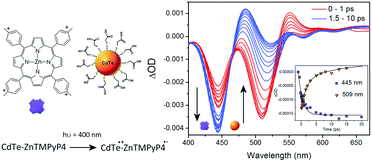Abstract
The photophysical properties of 2.3 nm

- This article is part of the themed collection: Dalton Discussion 13: Inorganic photophysics and photochemistry –Fundamentals and applications
* Corresponding authors
a
School of Chemistry and Chemical Biology, Centre for Synthesis and Chemical Biology, University College Dublin, Dublin 4, Ireland
E-mail:
susan.quinn@ucd.ie
Fax: +353 1 716 1178
Tel: +353 1 716 2407
b School of Chemistry, Trinity College Dublin, Dublin 2, Ireland
c Central Laser Facility, Research Complex at Harwell, Science & Technology Facilities Council, Rutherford Appleton Laboratory, Didcot, Oxfordshire, UK
The photophysical properties of 2.3 nm

 Please wait while we load your content...
Something went wrong. Try again?
Please wait while we load your content...
Something went wrong. Try again?
P. M. Keane, S. A. Gallagher, L. M. Magno, M. J. Leising, I. P. Clark, G. M. Greetham, M. Towrie, Y. K. Gun'ko, J. M. Kelly and S. J. Quinn, Dalton Trans., 2012, 41, 13159 DOI: 10.1039/C2DT30741C
To request permission to reproduce material from this article, please go to the Copyright Clearance Center request page.
If you are an author contributing to an RSC publication, you do not need to request permission provided correct acknowledgement is given.
If you are the author of this article, you do not need to request permission to reproduce figures and diagrams provided correct acknowledgement is given. If you want to reproduce the whole article in a third-party publication (excluding your thesis/dissertation for which permission is not required) please go to the Copyright Clearance Center request page.
Read more about how to correctly acknowledge RSC content.
 Fetching data from CrossRef.
Fetching data from CrossRef.
This may take some time to load.
Loading related content
